Lessons learned at Noble Ranches in our first year with guardian donkeys
Donkeys can be an economical way to protect small herds of sheep from predators, depending on your context.
Two of the guardian animals protecting sheep on Noble Ranches stand quite a bit taller than the seven dogs guarding the other small ruminants on Noble Research Institute properties.
Ruby and Thelma are jenny guardian donkeys that Noble added to its regenerative grazing operations last May to protect sheep from predators. Ruby watches over the 29 hair-sheep ewes and their lambs on the Conrad-McMillan Pecan Farm outside Madill, Oklahoma, along with Ranch Facility Manager David Miller.
Thelma’s assignment is protecting the 44 ewes and lambs just outside the west city limits of Ardmore, Oklahoma, on the Noble Pasture Demonstration Facility (known as PDF), where Brooks Braunagel is ranch foreman.
In the time since the first sheep were introduced to Noble Ranches in spring 2021, the small-ruminant herd has grown to 550 sheep and goats rotationally grazing and browsing on four of the six ranches. It’s been three years of numerous learning experiences for a ranch management team mostly used to cattle, says Joe Pokay, Noble general ranch manager, including some admittedly tough lessons in this first year with donkeys.
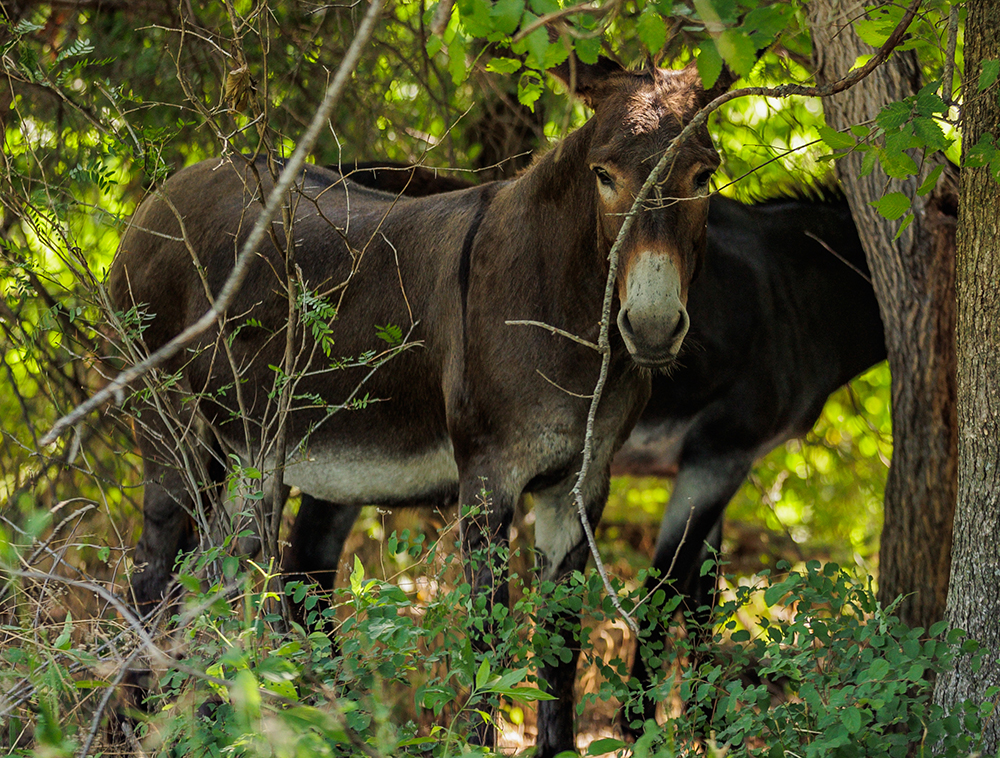
Lessons learned while giving donkeys a try
As Noble prepared to put sheep on PDF for the first time last spring, Pokay and the team figured it would be easier to contain a guardian donkey than guardian dogs in a setting so close to town and other small properties, with lots of people and dogs in the immediate area. They also wanted to experiment with donkeys to hold down costs, as they are cheaper to acquire and feed than dogs.
They started with a pair of jennies at PDF, Thelma and Louise, who had been trained to protect calves by their owners. Braunagel says they tended to stick together more than bond with the sheep. They also were rather stirred up at the beginning, which unfortunately resulted in Louise running during a move, stepping off the road into a hole and breaking her leg. She had to be euthanized.
“Everyone was just starting to get along,” Braunagel says, “but if I could do it again, I would have just picked up one donkey. They seem to bond with the sheep better when they don’t have another donkey to hang out with.”
He says that he expected Thelma to want to be near the horse he keeps there, “but if she has the option, she’ll want to go back to her sheep.”
The other hard lesson at PDF came, they believe, from a combination of its near-town location, being a 1,000-acre ranch surrounded by small 20- and 30-acre properties, no one living on the ranch, and the time of year they were lambing.
“We had some predation at PDF because we are lambing out of sync with nature,” Pokay says. To take advantage of a good market for grass-finished lambs, “we are lambing in the fall to have a more consistent supply of lambs to sell. So, we were having baby lambs in the fall when there’s not a lot of other things for predators to eat.”
Pokay and Braunagel believe it’s likely that packs of dogs, more than coyotes, were coming in and taking the lambs at night, as they had been doing with cats and chickens in the neighborhood. Braunagel moved the ewes and lambs so he could pen them up at night. With the sheep penned up and closer to the shop on the ranch, the predation slowed.
“Who’s to say without the donkey we might have lost more?” Braunagel wonders. They may consider switching to spring lambing at PDF or try adding guardian dogs to assist Thelma if predation continues to be an issue.
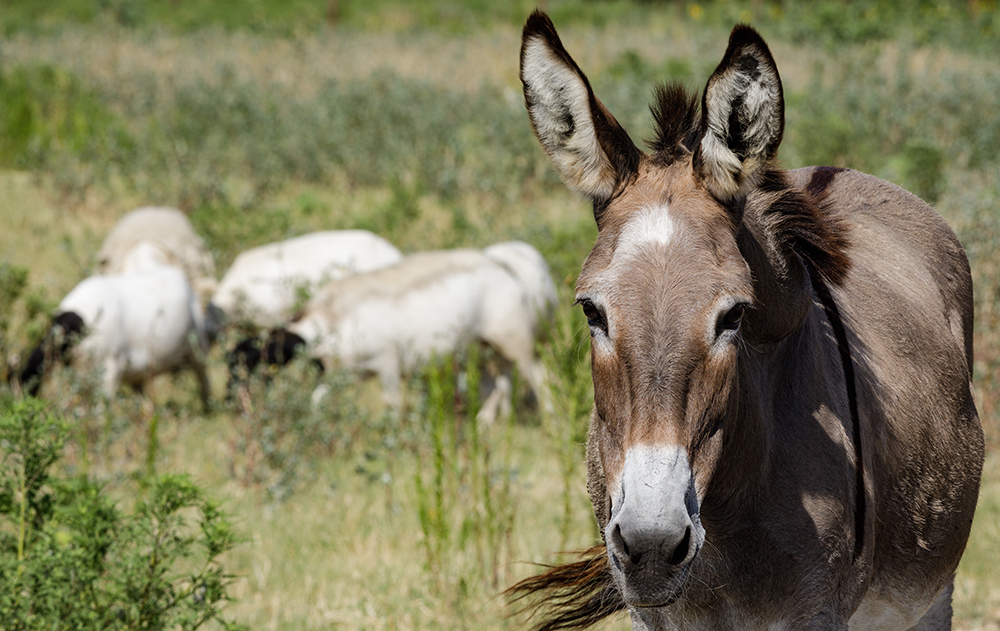
Better luck (mostly) at Conrad-McMillan location
Using donkeys as guardians went better for Miller at the Conrad-McMillan location, where the sheep graze in small paddocks in the pecan orchards as well as in small, open grazing areas on a ranch surrounded by other big ranches. He didn’t lose any lambs to predators, but he did lose Ruby’s partner jenny, Lucille, who died.
“When we started with two (donkeys), they were standoffish from the sheep,” Miller recalls. But since losing Lucille, “the remaining donkey has been with the sheep just like one of the flock. I would say she has to be doing some good, ’cause surely I would’ve lost something by now, especially with the lambs.”
Miller says he thinks context has a lot to do with how well donkeys do as guardian animals. Where he is, neighboring ranchers keep the coyote population down; there aren’t so many dogs around; and Ruby has a good line of vision in open terrain to watch for predators.
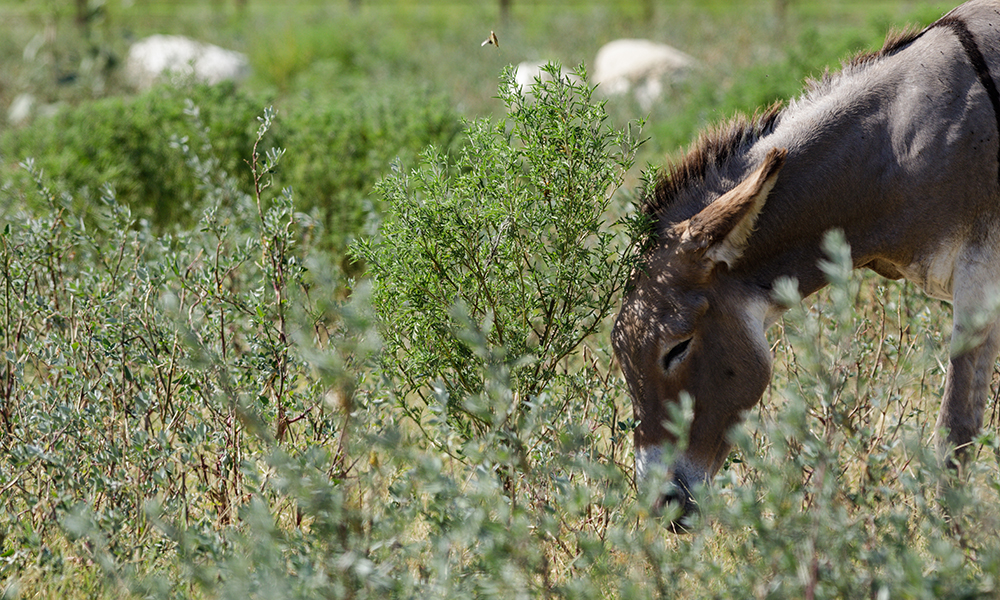
Where guardian donkeys might fit best
As mentioned before, economics is one of several reasons to consider using donkeys as guardians.
Kevin Lynch, a Noble research associate who has raised small ruminants for years and uses and trains guardian dogs, says while buying a trained dog at six months of age can cost from $300 to $1,000, a donkey may only cost $100 to $250. And donkeys will graze with the sheep, costing maybe $200 each in feed for a year, while maintaining dogs can mean a few hundred dollars in veterinary bills plus feeding purchased dog food that has been climbing in price.
“On a small herd, that’s what we were worried about,” Pokay says. “You can feed your way out of having a profit.”
Lynch says he thinks small operators who have 20-30 head of sheep should pen them at night for safety, especially if they live on their property, as guardian dogs may be too expensive as well as harder to manage close to a town and other dogs. A donkey or a llama could also be a consideration.
“I think a lot of it falls back into your context,” Braunagel agrees. “If you live on the place and you have 20 acres, I don’t think it’s a bad idea at all to put a donkey out there.”
Donkeys also have a long life span – up to 25 to 30 years. Still, the team agrees, the key is finding a donkey that knows how to be a good guardian, same as with choosing a guardian dog.
“Probably my favorite thing about my donkey is she remembers where all the gates are. I’ll let the gate down, and then I’ll go get behind them, and Thelma will kind of lead the way,” Braunagel says. “The sheep have some trust in her when they get to a gate – otherwise, they’re kind of funny about going through it sometimes.”
Miller is rather fond of Ruby, too.
“I’m not ready to give up on the donkey yet out here. I’ve had good enough luck that I’d like to keep going.”

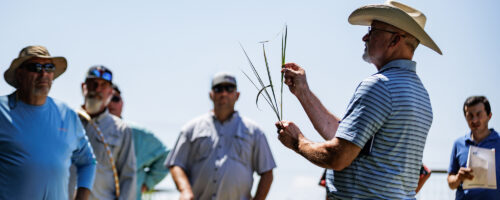
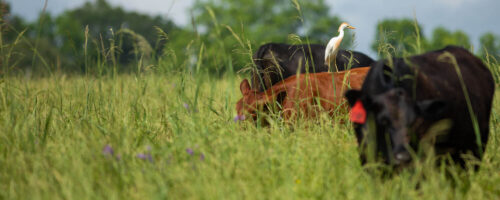
Comment